Introduction - Tour to Villages of Rajasthan
Rajasthani rural lifestyle is worth to see but much worthy is to gain its experience. There can be no better way to understand a great culture and lifestyle than living with such people. A stay of a couple of nights with a rural family in their own farmland can prove to be a welcome introduction to the unique agricultural practices, customs and eating habits. Festivals with people performing rituals and ceremonies are common.
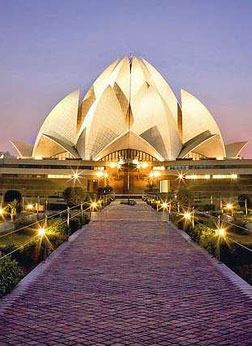 Lotus Temple - Delhi
Lotus Temple - Delhi
Day 01 : Delhi
On arrival at Delhi airport, meet & greet by our representative & transfer to Hotel.
New Delhi, the capital and the third largest city of India is a fusion of the ancient and the modern era. Standing along the west End of Gangetic Plain, the capital city, Delhi, unwinds a picture rich with culture, architecture and human diversity, deep in history, monuments, museums, galleries, gardens and exotic shows. Comprising of two contrasting yet harmonious parts, the Old Delhi and New Delhi, the city is a travel hub of Northern India.
Delhi is a palimpsest, bearing the complexities, the contradictions, the beauty and the dynamism of a city where the past coexists with the present. Many dynasties ruled from here and the city is rich in the architecture of its monuments. Diverse cultural elements absorbed into the daily life of the city have enriched its character.
Overnight at hotel.
Day 02 : Delhi
After breakfast leave for full day city tour of old & New Delhi, visit Red Fort, Jama Masjid, Raj Ghats, Lotus Temple, Laxmi Narayan Mandir, India Gate, President House and Qutub Minar. Overnight at hotel.
Day 03 : Delhi – Nawalgarh
Morning after an early breakfast, drive to Nawalgarh. On arrival, check into the hotel. Founded in the 18th Century by Nawal Singh, it has some of the finest frescos in the Shekhawati region. A huge fort with colourful bazaar and numerous havelis with elaborate architecture makes it an interesting destination for a 1day / 1 night stay. There are a few prominent havelis like Anandilal Poddar Haveli, Aath Haveli, Hodh Raj Patodia Haveli etc., which are to be visited, and so are the two forts and the palace hotel Roop Niwas that is a beautiful heritage property and is renovated with modern facilities. The Palace offers spacious painted rooms, Luxurious interiors, graceful hospitality and great thematic evenings with sumptuous cuisine. The registered painting in their Art Gallery is a treat to the visuals.
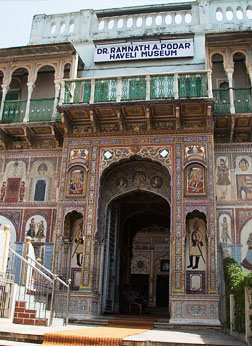 Dr. Ramnath A. Podar Haveli Museum
Dr. Ramnath A. Podar Haveli Museum
Day 04 : Nawalgarh – Kuchaman
In the morning after breakfast, drive to Kuchaman. Founded by Thakur Zalim Singh in 1781 AD, Kuchaman is a small village known for its impressive fort that has been converted into a grand heritage hotel today. Untouched by the forces of commercialization, Kuchaman exists in a state of blissful ignorance. In fact, Kuchaman is a wonderful place where you can observe the rural population of Rajasthan at its colorful and charming best.
On arrival at Kuchaman, check into the hotel. After fresh and change, visit the Fort. Perched atop a 1000 ft high cliff, the Kuchaman Fort is the most important attraction of Kuchaman. Converted into a heritage hotel now, the fort displays a rich collection of original inlay work in semi-precious stones, glass and gold paint. The Sheesh Mahal (glass palace) is a sight to marvel at. Meanwhile, a colorful bazaar located below the fort is a great place to shop for handicrafts and fabrics.
Day 05 : Kuchaman – Nagaur
In the morning after breakfast, drive to Nagaur. Glorified by the bards, the history of Nagaur finds mention even in the Mahabharata. The kingdom of Ahichhatrapur which Arjun is said to have conquered and subsequently offered to his Guru Dronacharya, was perhaps some of the area of the Nagaur district. The birth place of Meera and Abul Fazal, Nagaur district has a charbhuja and Parsawanath Temple at Merta and the Dargah of Sufi Saint Tarkin at Nagaur city. Nagaur also witnessed the valour of Great Rao Amar Singh Rathor who challenged the mighty Mughal empire. The large old Fort has many glorious tales of bravery of the erstwhile rulers of the states.
On arrival, check into the hotel. After fresh and change, visit the Nagaur Fort. Sandy fort; centrally located; 2nd century old; witnessed many battles; lofty walls & spacious campus; having many palaces & temples inside.
Day 06 : Nagaur – Khimsar
In the morning after a relaxed breakfast, drive to Khimsar. Perched on the edge on the great Thar Desert in the Heart of Rural India, the unique fort at Khimsar offers a wide range of Experiences. The Battle scarred walls and turrets remained one of the Glorious past. The initial Construction began in 1523 AD, the family moved in during the 18th Century When a new 'Zenana' (Ladies Wing) was constructed. Thakur Onkar Singh built a regal wing for himself in 1940s.Today the khimsar fort ranks high amongest the premier classified heritage hotels of India.
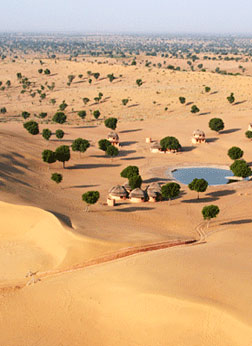 Khimsar Sand Dunes
Khimsar Sand Dunes
On arrival, check into the hotel. After fresh and change, visit the Khimsar Fort. The fort was originally built by Prince Karamasi but is marked by a lot of diversity in its architecture as the fort was built by different people in different periods of time. The fort was initially built as a protection mechanism for the village from foreign or neighboring invasions. The walls, turrets, and stables of the fort were built around 16th century AD only for the purpose of war. But, by the middle of the 18th century, the royal family shifted to the fort which led to the construction of a new zenana or ladies' residence. The ladies residence has intricately carved windows in stone, built in order to provide purdah or veil for the ladies in waiting. Thakur Onkar Singh, 17th direct descendant of Prince Karamsi is the current owner who added a regal wing in the 1940's for himself. Later the fort was converted into Heritage Hotel and ranks amongst the best Heritage Hotels of India.
Day 07 : Khimsar - Ranakpur – Kumbhalgarh
In the morning after a relaxed breakfast, drive to Kumbhalgarh. Enroute visit the Jain Temples at Ranakpur. On arrival at Kumbhalgarh, check tito the hotel.
In Kumbha's time the kingdom of Mewar spread from Ranthambore to Gwalior, including vast tracts of present-day Rajasthan and Madhya Pradesh. Mewar's rulers became patrons of all that was best in Indian martial and fine arts, architecture, and learning. Of the 84 fortresses defending Mewar, 32 were designed and built by Rana Kumbha. Of these, Kumbhalgarh with its 36-kilometer long wall and soaring towers is the most impressive. Kumbhalgarh stands on the site of an ancient citadel dating back to the second century AD belonging to a Jain descendant of India's Mauryan emperors. It defined the boundaries between Mewar and Marwar and became a refuge for Mewar's rulers in times of strife. Its steel gray ramparts encircle the fertile Shero Mallah Valley, with ancient monuments cenotaphs, ponds and flourishing farms. Kumbhalgarh fell only once in its history, to the combined forces of Emperor Akbar, Raja Man Singh of Amber, and Raja Udai Singh of Amber, and Raja Udai Singh of Marwar.
Day 08 : Kumbhalgarh
After a relaxed breakfast in the morning, proceed for a city tour of Kumbhalgarh. Visit Kumbhalgarh Fort : This most-remarkable of forts stretches across 36 kms of the Aravali Mountains and is 1100 m high from the sea level. It was never conquered, for reasons which become apparent the instant you set eyes on it. The fort is just 60 kms away from Udaipur. The massive perimeter wall is an astounding 36 kms. Surrounded by thirteen mountain peaks, guarded by seven great gates and seven ramparts, strengthened by rounded bastions and immense watchtowers, this mountain fortress has witnessed many battles. The winding road leads through deep ravines and thick forests to Arait Pol with its watch-tower, Hulla Pol, Hanuman Pol, Ram Pol, Bhairava Pol, Paghra Pol, Top-khana Pol and Nimboo Pol.
On top of the fort is the Badal Mahal Palace, It encloses beautiful rooms with pleasant colour schemes of green, turquoise and white, which provides a fascinating contrast to the raw, earthy and grim fortress. The palace was rebuilt by Rana Fateh Singh in the late 19th century. The legendary Maharana Pratap was born here.
In the post lunch session, visit the Kumbhalgarh Wildlife Sanctuary :: Sited in the flourishing green zone of Udaipur, Kumbalgarh is the only sanctuary of Rajasthan, where activities of the rarely found wolf can be seen. This is one of the few parks that allow people on horseback.
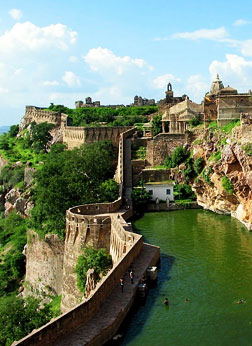 Chittorgarh Fort
Chittorgarh Fort
Day 09 : Kumbhalgarh – Chittorgarh
In the morning aftr breakfast, drive to Chittorgarh. The town of the brave, known for its massive fort atop a hill, which can be singled out for its glorious past. The fort has achequered history, it has witnessed some of the bloodiest battles in history, three great sakas and some of the most heroic deeds of velour, which are still sung by the local musicians.
The antiquity of chittorgarh is difficult to trace, but it's believed that Bhim the legendary figure of the Mahabharata, visited this place to learn the secrets of immortality and became the disciple of a sage, but his impatience to perform all the rites deprived him of his goal, and out of sheer anger he stamped on the ground creating a water reservoir, this reservoir is called as Bhimtal; Later on, it came under Mauryas or Muri Rajputs, there are different opinions as to when it came under the Mewar ruler, but it remained the capital of Mewar till 1568, when it was shifted to Udaipur.
On arrival, check into the hotel. After fresh and change, visit Fort, jay Stambha, Kirti Stambha, Rana-Kumbha Palace, Padmini Palace, Meera Temple and Kumbha Shyam Temple an Kalika Mata Temple, State Archaeological Museum.
Day 10 : Chittorgarh – Bundi
In the morning after breakfast, drive to Bundi. On arrival, check into the hotel. Bundi is a city of glorious past and promising future. Bundi has been rightly termed as the queen of Hadoti. Bundi has plenty of tourism potential ranging from heritage tourism , archeological tourism , spiritual tourism , eco-tourism , adventure tourism (rock climbing, para sailing & water sports) , leisure tourism and cultural tourism. The Bundi school of painting is world famous. Bundi is fascinating. Historical monuments, natural beauty, scenic dams & ponds,wild forests fairs and festivity.
After fresh and change, visit the Palace of Bundi. The palace is reached from the north - western end of the bazaar, through a huge wooden gateway and up a steep cobbled ramp. Only one part of the outer perimeter of the palace, known as the Chittra Shala, is officially open to public. It is a fascinating pavilion and has a gallery of miniature murals that embellish the palace. Elaborate colourful paintings on the walls depict scenes from the 'Raga mala' 'Raslila' -- the Radha-Krishna story. You can see the renowned Bundi murals at the Chattar Mahal and Badal Mahal within the palace complex.
Chattar Mahal is a steep, paved carafe-way is the only way to reach the monument. Of special interest in the palace is the Hazari Pol or Gate of the thousand, the Naubat Khana, the Hathi Pol with its old water clock and the Diwann-e- Aam. Flash photography is officially prohibited. The palace looks beautiful, from a distance and when illuminated at night.
Day 11 : Bundi – Pechawar
After breakfast drive to Pechawar.
Pachewar : A great land of culture offers equally great destinations like Rajasthan, where valour, chivalry and royalty have played a great deal in shaping the glorious traditions of its land and people…
Fort of Pachewar. 300 years old fort of picturesque Pachewar has now been converted into a luxurious heritage hotel with all modern amenities, where one can witness great traditions of royal hospitality. A well preserved tranquil fort with its massive ramparts imposing gates, intricate balconies and spacious apartments, adorned with antique frescos of exquisite beauty. To Pachewar is only 25 minutes drive from Dudu a small town - situated on Jaipur-Ajmer National Highway on Dudu-Malpura road, renowned for its traditional textiles.
Pachewar Fort also provides you opportunities of bird watching, fishing, campfire, theatre, folk music and dances. Royal safaris on horseback, camels, and jeep may also be arranged on request for Diggi (15 kms), where exists a renowned temple of Kalyanji. Stepwells of Toda Rai Singh (55 Kms.), Ajmer (90 Kms.), & Pushkar (90 Kms.)
The itinerary of local sightseeing includes a visit to the royal cenotaphs, built on the banks of Pumpa Sagar Lake, ancient temples and intimate exposure to the village - life, where you can watch the village craftsmen and artisans creating delicate blue pottery, cosy carpets, colourful tie and dye, and terracotta. Nomadic 'Gadia-Luhars' (iron-smiths) tempering the red-hot iron carrying their entire house-hold in a single bullock-cart can also be watched here.
Day 12 : Pechawar – Karauli
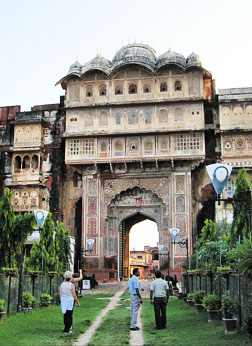 Karauli Palace - Karauli
Karauli Palace - Karauli
In the morning after breakfast, drive to Karauli. On arrival at Karauli, check into the hotel. Karauli is a sylvan delight packed in a rural ambience. It was founded in 1348AD by one Raja Arjun Pal. In those days Karauli used to be the capital of a small state of the same name. Legend has it that the ruling family were descendants of Lord Krishna, one of the most loved god of Hindu mythology. As such they occupy the topmost rank among the Yaduvanshi Rajputs and their family history is rich with tales of valour and glory.
Today Karauli, famous for its pale red sandstone, is also known as a holy place. There are some old monuments you could see here, apart from exploring the rambling countryside and the game sanctuary. There are excellent opportunities for jeep safaris and boating too. Do make it a point to visit the local bazaar where you get good handicraft items, especially the colourful bangles of Karauli. A major socio-religious event here is the Kaila Devi fair. Kaila Devi is an important deity of Karauli with a temple dedicated to her. A big cattle fair is also held in the month of phalguna (February-March), where camels, horses and buffaloes go on sale.
Day 13 : Karauli – Peharsar
In the morning after breakfast, drive to Peharsar. In the 17th century, Mughal Emperor Akbar conquered Peharsar in all of three hours (a pehar) - hence the name Peharsar.
A quiet village close to Bharatpur, Peharsar may not be your ideal tourist destination. Nevertheless, it has its own charm. The pace of life, the ambience, the serenity, are all worth experiencing. It certainly makes for a relaxing change.
This sleepy village is said to have been a flourishing commercial center. The enormous havelis in Peharsar are believed to have been a reason for the prosperity of the village. However, most of these are now crumbling structures, making for interesting excursion sites.
Chandra Mahal Haveli : Now a heritage hotel, it was built in 1699 by Akbar's nobles. The majesty and grandeur of the haveli reflects the magnificence of Mughal architecture to this day. Although it has been renovated and refurbished from time to time, it still retains its old charm. The name itself is a later addition.
Day 14 : Peharsar - Agra – Delhi
In the morning after breakfast, drive to Delhi Enroute visit the Taj Mahal at Agra (closed on Firday). On arrival at Delhi, transfer to hotel for overnight stay.
Day 15 : Delhi
In time transfer to airport to connect flight for onwards destination.